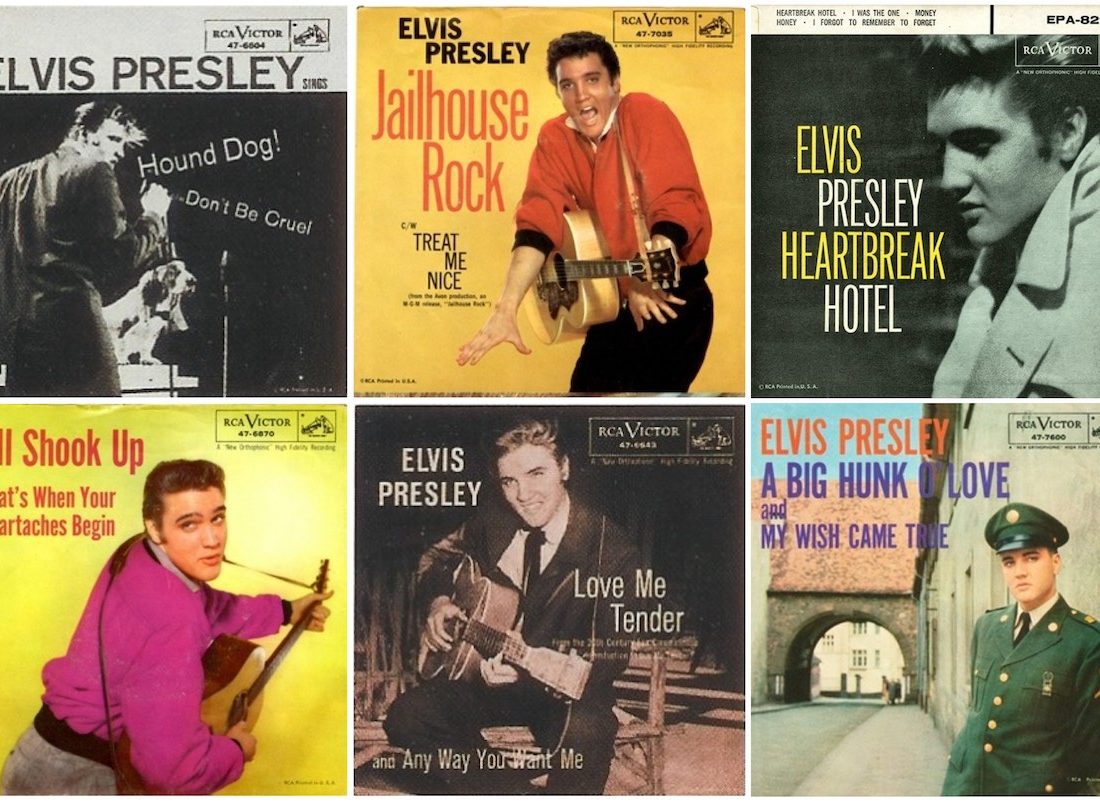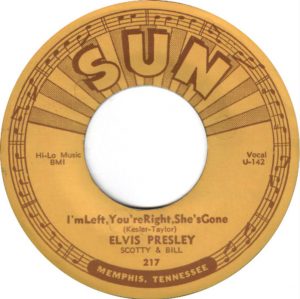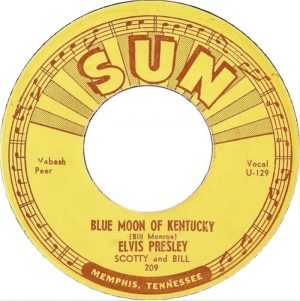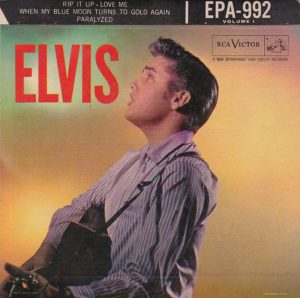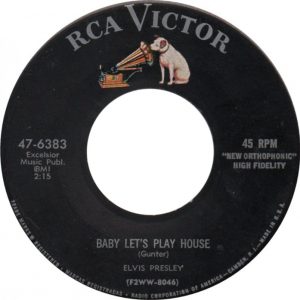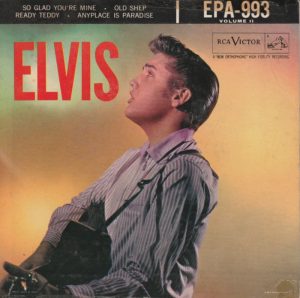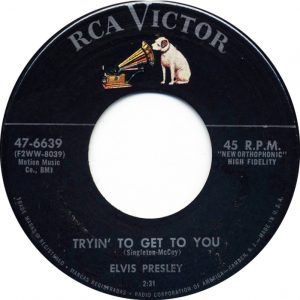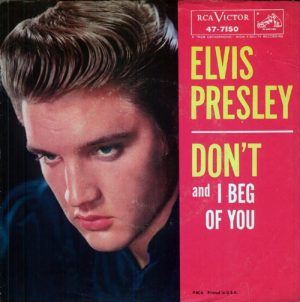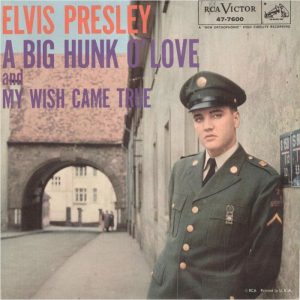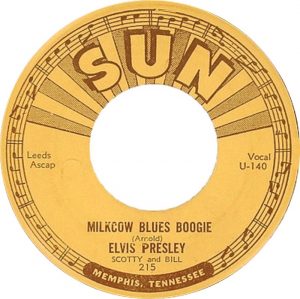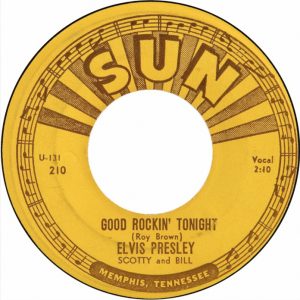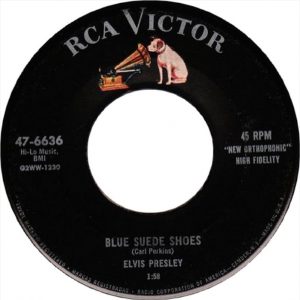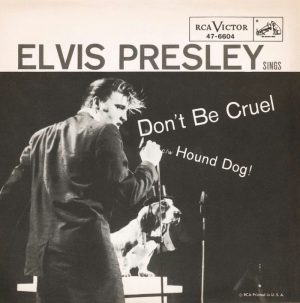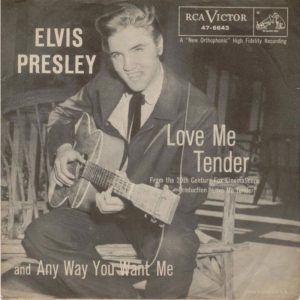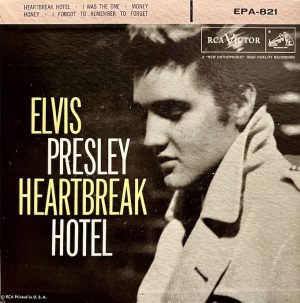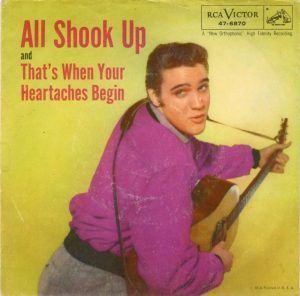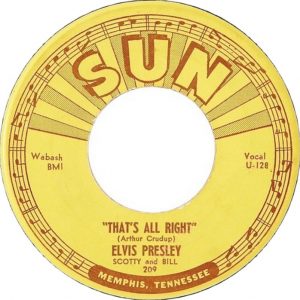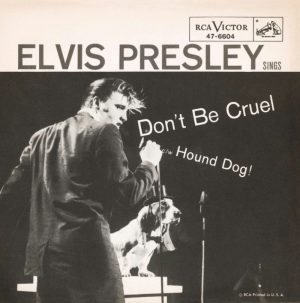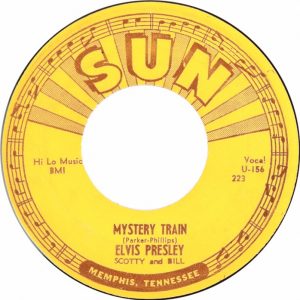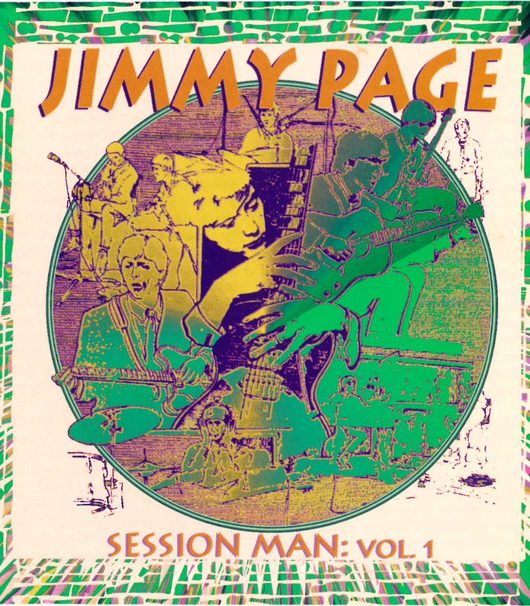The King’s early years are packed with rock’n’roll classics. Vintage Rock sifts through the hundreds of songs that the Hillbilly Cat recorded during the 50s for our Elvis Presley Top 20 (1954-59) rundown…
Compiled by Rik Flynn
They were, for many Elvis fans, his greatest years behind the microphone, certainly for those more aligned with the electrifying thrill of his hip-thrusting days as the Hillbilly Cat as opposed to the more sanitised, soft-focus Hollywood headliner.
As such, this list is stacked full of classic rock’n’roll from Elvis’ Sun Records period alongside some of those first incendiary tracks recorded for his new major label, RCA. Of course, plenty of these sides are amongst the most famous songs ever committed to wax and impossible to ignore, while we’ve settled on a small handful of lesser-known tunes that should be getting a whole lot more attention.
Of course, there could have been several completely different versions of this rundown, such was the strength of the King’s output during that initial explosive period. Missing waxings deserving of a slap-backed shout-out include the likes of Money Honey, I Need Your Love Tonight, Too Much, Blue Moon, (Let Me Be Your) Teddy Bear, Stuck On You, Hard Headed Woman and One Night, amongst the endless magic captured by Elvis and co in the 1950s.
Nonetheless, read on and discover a playlist that’s pretty damn near perfect, classics that soundtracked the dawning of the teenager, lovers’ kisses shared at many-a drive-in – and the big beat revolution.
20 I’m Left, You’re Right, She’s Gone (1955)
Clever nomenclature straight out of the country songbook aside, this raw and rocking slice of wax soundtracking humourous heartbreak is a fine path into Elvis’ early Sun sound. Released as a single in 1955 and written by Snearly Ranch Boys Bill Taylor and Stan Kesler, this was supposedly based on a Campbell’s soup jingle (Kesler also worked with Carl Perkins and Jerry Lee Lewis at Sun). The track was laid down at a session in March 1955, where a slower version was also captured, with session drummer Jimmie Lott adding the rhythm on both. I’m Left, You’re Right, She’s Gone was also later commandeered by Jerry Lee and fellow Sun artist Hayden Thompson.
19 Blue Moon Of Kentucky (1954)
Written in 1945 by bluegrass legend Bill Monroe as a waltz and released with his group the Blue Grass Boys (featuring icons, guitarist Lester Flatt and banjo player Earl Scruggs), this became the official bluegrass song of Kentucky. Bassist Bill Black brought the song to Elvis, starting up a goofy version in the studio that Elvis joined in on. With Sam Phillips’ encouragement,they upped the tempo, changed the time signature and added a hep cat spark that would close the deal as a fine plattermate to That’s All Right. Sun alumnus Charlie Feathers has claimed it was he who came up with the arrangement with Moore, but Scotty doesn’t recall this ever happening.
18 Love Me (1956)
Lieber & Stoller initially gave this to R&B pairing Willy & Ruth, who sent a slightly more boisterous version out as a single on Spark Records in 1954, with several vanilla covers following immediately in its wake, from the likes of Georgia Gibbs and Kay Brown amongst others. Elvis chose to take it on in 1956 for his Elvis Volume 1 EP and eclipsed all versions that came before him, climbing to No.2 on the Billboard and, while not released as a single to avoid any mix-up with the then recent single Love Me Tender, aired it on The Ed Sullivan Show that October, a performance during which he comically forgot the words. The track also appeared on his iconic 1968 NBC Network Comeback Special.
17 Baby Let’s Play House (1955)
Elvis’ hiccuping rockabilly reimagining of Baby Let’s Play House began life as a rhythmic blues from Arthur Gunter, a dusty treasure from 1954 on Excello (itself based on Eddy Arnold’s 1951 Country No.1 I Want To Play House With You). Elvis reworked the track in the mid-50s with the Blue Moon Boys, switching up the arrangement, adding a rockin’ posture and transforming it into something entirely fresh, in which religious references were exchanged with the gleaming new pink Cadillac Elvis now had proudly parked in his driveway. This was the soon-to-be King’s first charter, registering at No.5 on the Billboard Country Charts. It also made No.84 in the UK.
16 Ready Teddy (1956)
One need only take a look at Elvis and his band blowing the roof off Ed Sullivan’s show in early September 1956 to get a whiff of the visceral thrills and chills that accompanied the birth of rock’n’roll, from the Hillbilly Cat’s kooky charisma and DJ Fontana’s crackerjack snare rolls to the constant screaming from the girls glued to Elvis’ every move in the stalls. Ready Teddy was penned by Otis Blackwell with John Marascalco and was, of course, first issued a few years earlier by Little Richard on Specialty with Rip It Up on the flip – another track recorded by the King. Scooty Moore’s flighty fretting replaced the tenor sax, provided on the original by New Orleans figurehead Alvin ‘Red’ Tyler.
15 Trying To Get To You (1956)
Rarely featuring in anyone’s top Elvis lists, but a favourite here at Vintage Rock – if only as it grooves just as hard as the better-known classics – this is a window into the Hillbilly Cat in his electrified formative phase, the unstoppable furnace that youth provides roaring as bright as it ever had. Written by prolific hit songwriting duo Rose Marie McCoy and Charles Singleton, this was initially delivered by Washington DC vocal group The Eagles in 1954 on Mercury. And with Scotty’s vibrant solo dropping where the sax once honked on the original, this was cut in July 1955 and found its rightful place on Elvis’ debut album. (Notably, Roy Orbison also recorded the track as the flip of Ooby Dooby.)
14 Don’t (1958)
Another cracker from Lieber & Stoller, the simply titled Don’t was a sumptuous ballad featuring some of the Jordanaires strongest backing, while Elvis is in magical form as he tries to restore his lover’s interest via his blissful, amorous tones. Cut at Radio Recorders Studio 1 in Hollywood in early September 1957 alongside several Christmas songs, and released as a single soon after, the tune also features on 1959’s far more lengthily-titled 50,000,000 Elvis Fans Can’t Be Wrong: Elvis’ Gold Records, Vol. 2. Don’t was Elvis’ eleventh Billboard No.1 and also made No.4 in the US R&B charts, the third biggest hit of the year. The stunning 2016 remake with the Royal Philharmonic is well worth a spin too.
13 A Big Hunk O’ Love (1959)
Reclaiming his throne on his return from the Army (not that he’d lost it) via a two-week stay at Billboard No.1, 1959’s A Big Hunk O’Love is the perfect amalgamation of the Jordaniares – wild yelps mixed with silky harmonising – and Elvis, with drummer DJ Fontana and some classy ivory-pounding from Floyd Kramer. Written by Aaron Schroeder and Sidney Wyche, recorded in Nashville in 1958 and released in June 1959, this kitchen-sink R&B rocker featured yet more mighty guitar-playing, this time provided by Hank Garland, the first Elvis session not to feature Scotty. Elvis added the track to his Vegas sets in 1972 and featured it in his 1973 satellite broadcast, Aloha From Hawaii Via Satellite.
12 Milkcow Blues Boogie (1955)
Released as a single in 1955 to follow up Good Rockin’ Tonight, this is one of the King’s first recordings at Sun – and one that missed the charts altogether. Adapted from Kokomo Arnold’s 1934 song Milk Cow Blues, Elvis and crew begin the song at a similar tempo to Arnold’s winding acoustic blues, before Elvis calls a stop to preoceedings: “Hold it fellas, that don’t moveme!” he drawls. “Let’s get, real, real gone for a change!”, triggering a fidgety, thumping bass-driven rockabilly freight train, augmented by Scotty’s fret-bounding licks – and a wonderful moment in rock’n’roll history. It was later added to the A Date With Elvis LP in 1959.
11 Good Rockin’ Tonight (1954)
“Well I heard the news, there’s good rockin’ tonight!” Jump blues superstar Wynonie Harris’ had had a mammoth R&B No.1 smash in 1948 with Roy Brown’s tasty confection, whose pumping original version, then titled Good Rocking Tonight, had fired up joints up and down New Orleans, in turn persuading Harris to take it on in the first place – both versions were fiery proto-rock’n’roll at its absolute finest. The track was ideal for Sam Phillips’ latest red hot signing’s second Sun Records delivery, released on 22 September 1954 – and Elvis gave it everything he’d got. And while the track tanked at the time (a lowly US No.74), it’s now right up there as a classic recasting from the King.
10 Blue Suede Shoes (1956)
Much like Big Mama Thornton’s Hound Dog, many believe this version of Blue Suede Shoes to be the original, when of course it was Carl Perkins. The theme came from one of Johnny Cash’s Air Force pals calling his army footwear his “blue suede shoes”. When Carl overheard a guy telling his gal, “don’t step on my suedes!”, the stories combined and he wrapped it up that night. With the hip ‘Go cat, go!’ phrase added, it had soon won over Memphis, shifting 20,000 copies a day in Dallas alone. Now at Billboard No.2, tragedy struck en route to Perry Como’s TV show, when Carl was involved in a horrific car crash. Elvis asked Carl in hospital if he could cut it, soon to open his debut LP.
09 Don’t Be Cruel (1956)
After an abandoned Nashville studio session, Elvis was New York-bound to appear on The Steve Allen Show and producer Steve Sholes decided to take the star to RCA studios in the city for another try. Chosen from a pile of acetate demos given him by his publisher Hill & Range’s Freddy Bienstock, infectious bop Don’t Be Cruel would be issued as an A-side together with Hound Dog on the flip and, while the latter bounded up the Billboard first, its platter partner followed rapidly behind, reaching the top spot and shifting four million copies to boot, Elvis’ biggest hit. By September 1956, Presley was singing it on that first seismic appearance on The Ed Sullivan Show.
08 Paralyzed (1957)
Another penned by Otis Blackwell, Paralyzed was recorded in September 1956 at Radio Recorders and released in late 1956, Elvis’ backing quartet the Jordanaires elevating this snappy pop-rocker with consummate ease. Issued as part of 1956’s Elvis LP, it reached only No.59 on the Billboard. Blackwell suggested its failure was down to was the word ‘paralyzed’ – “a lot of organizations got down on the thing,” he told Time Barrier Express, “so they wouldn’t release it as a single” (it would be issued as an official US single in 1983). Nonetheless, it fared better here, out on HMV, piercing the Top 10 in August 1957. The song later got an airing around the 88s during the Million Dollar Quartet sessions at Sun Studio, and at the Louisiana Hayride.
07 Love Me Tender (1956)
Augmenting Elvis’ first picture of the same name as its softly purred theme tune, Love Me Tender was unveiled during his first slot on Ed Sullivan, resulting in a flood of pre-orders – over a million – and the first record to make gold status prior to its release. Sentimental and sublime, this floating lullaby was based on minstrel song Aura Lee, first published in 1861, that told the tale of a “maid of golden hair”. A popular campfire song from the American Civil War, the song lived on via barber shop quartets and in a few films, before the movie’s musical director Ken Darby picked it up as Elvis’ first non-rocker, changing the lyrics to suit his cause (his wife Vera Matson is credited). Cut in August 1956, it was a surefire No.1.
06 Jailhouse Rock (1957)
Another from the mighty Lieber & Stoller partnership, Jailhouse Rock has a world-famous intro to rule all others and instantly conjures up the big-production number from Elvis’ classic 1957 movie in all who hear it. The film also featured Presley’s band members DJ Fontana, Scotty Moore and Bill Black, his backing band in the movie, with Mike Stoller on piano. Yet another Billboard No.1 in October that year, Jailhouse Rock held off the competition for a whopping seven weeks, as well as making the top spot on the Country and R&B charts – and in the UK. The song is one of the Rock And Roll Hall Of Fame’s 500 Songs That Shaped Rock And Roll and was inducted into the Grammy Hall of Fame.
05 Heartbreak Hotel (1956)
Heartbreak Hotel elevated the Memphis marvel high above the pack with his first No.1 – all prior to his Ed Sullivan TV breakthrough. Written by 41-year-old high school teacher Mae Boren Axton and steel guitarist Tommy Durden, it was an unusal choice thanks to its morose subject matter, inspired by a suicide note with the line “I walk a lonely street” seen by Durden in a newspaper story. Axton had promised Elvis a million-seller while working for Colonel Parker in 1955 and she wouldn’t disappoint – “Hot dog Mae, play it again!” Elvis gushed upon hearing the demo. Just after his 21st, he entered his first RCA session in Nashville and, what for Sam Phillips was a “morbid mess”, would electrify all others.
04 All Shook Up (1957)
One more from Elvis’ go-to songsmith Otis Blackwell, the King’s love-struck rocker All Shook Up rocketted to Billboard No.1 in 1957 and bedded in for an eight-week stay at the top. With Elvis chasing a follow-up after Don’t Be Cruel, Blackwell recalled a meeting with Shalimar Publishing’s Al Stanton to Time Barrier Express: “[Stanton] walked in one day with a bottle of Pepsi, shaking it, as they did at the time, and said, “Otis, I’ve got an idea. Why don’t you write a song called ‘All Shook Up’.” Otis took up the challenge, finished it in a matter of days and, amidst a string of hits, Elvis took care of business once again. Soon to be Billboard’s biggest hit of 1957, it would resurface on his NBC Comeback Special in 1968.
03 That’s All Right (1954)
The song that started it all, this Arthur Crudup-penned delta blues was transformed into roughhewn country rock the minute Elvis and co go their hands on it. Uninspired during a July 1954 session, Presley went through his repertoire, eventually landing on this. Bill and Scotty joined the jam and the alchemy soon took shape: “All of a sudden, Elvis just started singing this song, jumping around and acting the fool, and then Bill picked up his bass, and he started acting the fool, too, and I started playing with them,” Moore remembered. Sam Phillips, listening with the studio door ajar, liked what he heard and hit the record button. Memphis fell for the 45 thanks to DJ Dewey Phillips and soon it was owning the nation’s airwaves.
02 Hound Dog (1956)
Many may have had this down as No.1, and fair enough, it being the 45 that really set the world ablaze after Heartbreak Hotelhad given Elvis his first Billboard chart-topper.
For one, he appeared on national TV on The Milton Berle Show, The Steve Allen Show (serenading a female basset hound dressed in white tie and tails, no less) and, most crucially, The Ed Sullivan Show, to perform it, inciting a wave of moral-panic across the States, parents swiftly covering the eyes of their kids, and illiciting excitations amongst the hormones of said newly-christened teenagers – the dictionary definition of a frenzy all round.
Rock’n’Roll Heaven
Lieber & Stoller’s superbly crafted rhythm and blues was, of course, originally written for the rambunctous powerhouse Big Mama Thornton and released in 1953. Mind you, Thornton’s sizeable pipes took Hound Dog elsewhere, a booming, playful attack on her no-good man – and frankly perfect in every way. Presley’s more commercially paletable turn may have sold 10 million, but Thornton’s half a million and the fact that she went to R&B No.1 for 14 weeks with it, was an incredible achievement given the segregated America it was thrust into.
Some might say hers is the superior version. That said, Elvis had likely decided to take it on having heard Freddie Bell and the Bellboys’ jauntier, more crowd-pleasing version in Vegas, in which Bell swapped man for dog, and this – coupled with Presley’s wilder edge – made for rock’n’roll heaven.
01 Mystery Train (1955)
B.B. King recalled Elvis being the only white boy in the room when the Beale Streeters fired up Memphis’ infamous blues alley. Sun Records boss Sam Phillips was also tuned in, signing up King’s musical comrade Herman ‘Junior’ Parker to his label. And so it stands to reason that one of three tracks Elvis and the Blue Moon Boys cut at Sun Studios on 11 July 1955 would be Mystery Train, Parker’s propellant second waxing for the label back in 1952.
Yet, while Parker and the Blue Flame’s ghostly, shuffling groove – with Junior’s train-whistling harmonica and (in all likelihood) Floyd Murphy’s vibeful fretwork – was Memphis blues through and through, Elvis and his comrades came at it from a different tack.
Crackling With Energy
What began as country-folk 12-bar, Worried Man Blues by The Carter Family laid down back in 1930, was reinvigorated, crackling with energy, “so embedded in Elvis’ mind that when he started to sing it,” Phillips once said, that “it was as natural as breathing… like you’re just rolling off of a log.”
Scotty incorporated Pat Hare’s proto-rockabilly guitar licks lifted from Parker’s flip Love My Baby, with Elvis oozing God-given charisma, adding a feverish intensity absent from the original. Elvis’ fifth 45 for Sun (coupled with I Forgot To Remember To Forget), landed the Hillbilly Cat his first placing in the Country charts. RCA had soon doled out the unthinkable fee of $40,000 for his contract and his starward path was set. Elvis never lost love for his roots and would return to Mystery Train in Vegas in the late 60s, often opening his sets with it.
For more on Elvis click here
Enjoy this article? Check out our The Alternative Elvis Top 20 (1953-1959)

